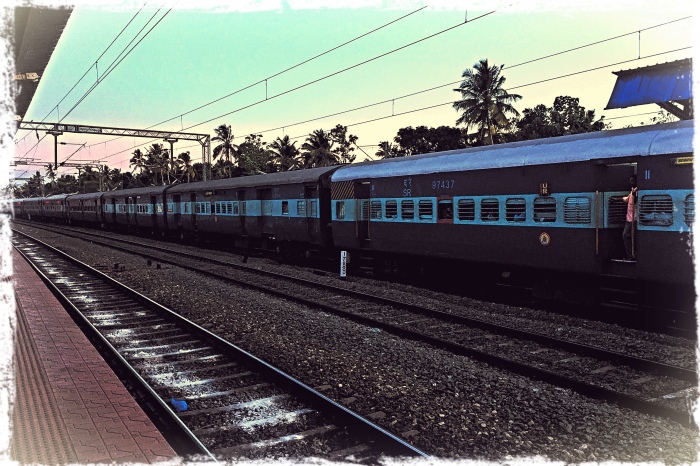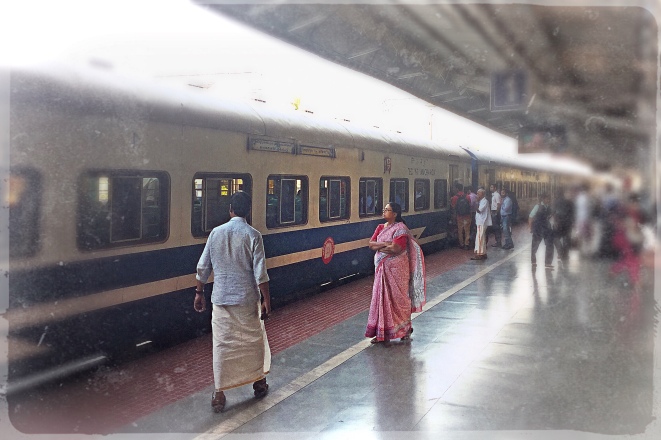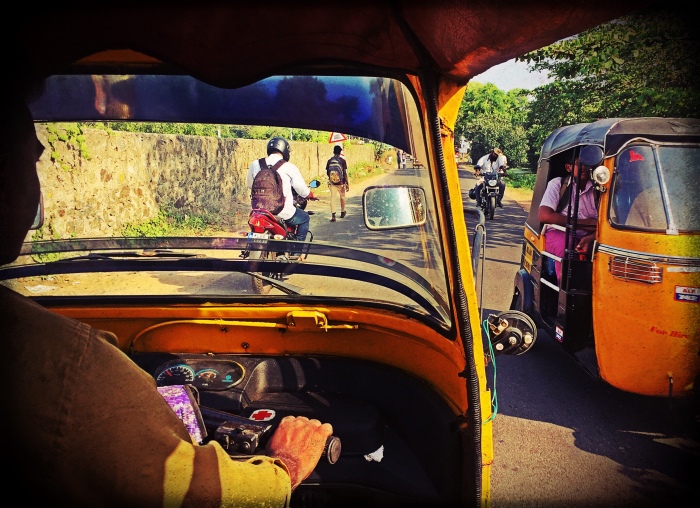It was a ludicrously early 5am when the tuk-tuks rattled into the small forecourt of the Dreams Beach Resort. Bags and half asleep people were loaded aboard and then we swarmed off to Varkala railway station. The morning air was pleasantly cool and apart from the lawn mower engine clattering away beneath me, the atmosphere was one of a rarely experienced calm and tranquillity. Along the roadside; locals, dogs and holy cows all slept peacefully together amidst the muck and mire. India was at rest!

We spluttered to a halt outside of Varkala railway station in a cloud of dust and 2-stroke fumes. I was keen to be getting to grips with the Indian Railways once again, having such fond memories of my previous trip across northern Indian almost 10 years ago. There is an oddly comforting familiarity to be found on the railway. I think this is largely due to the fact that the British pretty much built the entire network in the mid 19th century when they were keen to create an efficient way to transport their plunder to the coastal ports. Agreeably colonial rule had its faults, but the Indian Railway (IR) system is a legacy worthy of at least some small celebration. Today IR is the lifeline of the nation and is uniquely linked into the sensibilities of the people and the culture. Yes, the rolling stock may be old, the facilities basic, the infrastructure crumbling and timetables largely a work of fiction; but in my humble opinion, no trip to India would be complete without a train journey.
On the platform I was eager. To pass the time I headed off to find a Chai Wallah. Ordinarily, I never drink tea but when travelling by train in India it’s basically the law. For the lavish sum of 10Rp (roughly 10p), I received a delicious cup of sweet, milky masala chai and a packet of biscuits. I blissfully whiled away the next quarter of an hour perfecting the fine art of dunking. When the train finally arrived we clambered aboard and settled down for our 3-hour journey north to Alleppey, the gateway to Kerala’s famous backwaters.

Out of the window I watched mile upon mile of lush green coconut trees, banana plantations and rice paddies pass by. Anywhere else in the world, this would be considered a paradise but in India, it’s a word that seldom sits at the forefront of one’s mind. As a country, India is impossible, to sum up in just one word or even a single sentence. A journey through India is often and accurately described as an assault on the senses and at times it can be a slightly unpleasant one. To the ears it is a constant cacophony of engines, car horns, chattering people and barking dogs with the odd Islamic call to prayer and unnecessarily amplified Bhangra beats thrown in for good measure. On the nose, India can be particularly challenging. The fragrant spices, aromatic oils and incense are all to frequently overpowered by the stench of rotting organic matter, human piss and of course the shit of the holy cows and others. Visually, you get everything from the sublime to the ridiculous. Thankfully, it seems that nature manages to emerge victorious in spite of India’s best efforts to destroy it. As the train passes endless masses of rubbish and abandoned junk, I struggle to fathom how a nation of people can have such little regard for the environment which they have to live in. To me, it seems that, when the British buggered off in 1947, India as a collective conscious thought “screw the housework, we’re gonna put our feet up and have a chai”. In the 70 or so year since, no bugger has bothered to have a tidy up, let alone carry out a few routine maintenance jobs!

My musings were interrupted by our arrival into Alleppey. We spilt out onto the platform and then made our way by tuk-tuk to the jetty for the final leg of today’s journey. In another thrilling episode of wacky races, the tuk-tuk pilots jockeyed for position as we buzzed through the chaos and arrived almost simultaneously at our destination. We loaded ourselves on to the small motorboat and finally cruised away from the turmoil into the tranquillity of the backwaters.
The backwater is a picturesque palm-lined network of around 1,500kms of inland canals, rivers and waterways. They are unique to Kerala and provide the perfect antidote to India’s perpetual commotion that can become quite debilitating. I removed shoes and socks, mitigated the puttering engine with earphones and a few well-chosen tunes and let the serenity wash over me. Once beyond the citadel of houseboats, we were soon gliding past sleepy villages where women washed clothes on the river bank, children frolicked in the water and fishermen went about their business. All too soon the boat nudged up against the bank and we had arrived at the home of Mr Venugopal, where I was graciously welcomed with a little pink flower and a white dot to the forehead!

A delicious home-cooked lunch was served at 1 o’clock and the siesta, which was fast becoming part of my daily routine, followed immediately afterwards. Afternoon tea was at four-thirty and then the delightful Mr Venugopal took us for an informative tour through his gardens and rice fields. We cruised back in a pole boat and then it was time for more home cooked curry and an early night. Perhaps paradise wasn’t completely lost after all.
Are you still there and blogging? Haven’t seen one for ages. (blog, I mean).
LikeLike
Really loving these stories. And the photos are delicious!
LikeLiked by 1 person
Thanks Jawbone … it a fun journey so far and it’s not over yet!
LikeLike
Great read over my porridge this morning!
LikeLiked by 1 person
Fantastic blogging
Clarky 👍
LikeLiked by 1 person